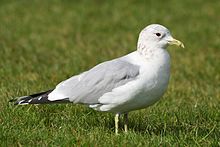- Common Gull
-
- For the butterfly, see Cepora nerissa.
Common Gull 
Adult Mew Gull. Anchorage Coastal Wildlife Refuge, Alaska. Conservation status Scientific classification Kingdom: Animalia Phylum: Chordata Class: Aves Order: Charadriiformes Family: Laridae Genus: Larus Species: L. canus Binomial name Larus canus
Linnaeus, 1758The Common Gull (European and Asian subspecies; see below) or Mew Gull (North American subspecies) Larus canus is a medium-sized gull which breeds in northern Asia, northern Europe and northwestern North America. It migrates further south in winter.[2] Its name does not indicate that it is an abundant species, but that during the winter it feeds on common land, short pasture used for grazing.[3]
Adults are 40-46 cm long, obviously smaller than the Herring Gull, and slightly smaller than the Ring-billed Gull, also differing from this in its shorter, more tapered bill with a more greenish shade of yellow, as well as being unmarked during the breeding season. The body is grey above and white below. The legs are greenish-yellow. In winter, the head is streaked grey, and the bill often has a poorly-defined blackish band near the tip (sometimes sufficiently obvious to cause confusion with Ring-billed Gull). They have black wingtips with large white "mirrors". Young birds have scaly black-brown upperparts and a neat wing pattern, and grey legs. They take two to three years to reach maturity. The call is a high-pitched "laughing" cry.[2][4]
Contents
Taxonomy
There are four subspecies, two of them considered distinct species by some authorities:[2][5]
- Larus canus canus Linnaeus, 1758 – Common Gull. Europe and western Asia. Small; mantle medium grey (palest subspecies); wingtips with extensive black; iris dark. Wingspan 110–125 cm; mass 290–480 g.
- Larus canus heinei Homeyer, 1853 – Russian Common Gull . Central northern Asia. Medium size; mantle dark grey (darkest subspecies); wingtips with extensive black; iris dark. Mass 315–550 g.
- Larus canus kamtschatschensis (Bonaparte, 1857); syn. L. kamtschatschensis – Kamchatka Gull. Northeastern Asia. Large; mantle medium-dark grey; wingtips with extensive black; iris pale. Mass 394–586 g.
- Larus canus brachyrhynchus Richardson, 1831; syn. L. brachyrhynchus – Mew Gull or Short-billed Gull. Alaska and western Canada. Small; mantle medium-dark grey; wingtips with little black and much white; iris pale. Wingspan 96–102 cm; mass 320–550 g.
Ecology
Both Common and Mew Gulls breed colonially near water or in marshes, making a lined nest on the ground or in a small tree; colony size varies from 2 to 320 or even more pairs. Usually three eggs are laid (sometimes just one or two); they hatch after 24–26 days, with the chicks fledging after a further 30–35 days. Like most gulls, they are omnivores and will scavenge as well as hunt small prey. The global population is estimated to be about one million pairs; they are most numerous in Europe, with over half (possibly as much as 80-90%) of the world population.[6] By contrast, the Alaskan population is only about 10,000 pairs.[2]
Vagrancy
The Common Gull occurs as a scarce winter visitor to coastal eastern Canada and as a vagrant to the northeastern USA,[7] and there is one recent record of Mew Gull in Europe on the Azores.[8]
Other names
An old historical name for the Common Gull is sea mew,[9] from the old English mǣw.
External links
- Common Gull videos, photos & sounds on the Internet Bird Collection
References
- ^ BirdLife International (2004). Larus canus. 2006. IUCN Red List of Threatened Species. IUCN 2006. www.iucnredlist.org. Retrieved on 11 May 2006. Database entry includes justification for why this species is of least concern
- ^ a b c d del Hoyo, J., et al., eds. (1998). Handbook of the Birds of the World 3: 621. Lynx Edicions ISBN 84-87334-20-2.
- ^ Okill, Dave (2004) English names for Western Palearctic birds British Birds 97(7): 348-9
- ^ Snow, D. W. & Perrins, C. M. (1998). The Birds of the Western Palearctic Concise Edition. OUP ISBN 0-19-854099-X.
- ^ Olsen, K. M., & Larsson, H. (2004). Gulls of Europe, Asia and North America. Helm ISBN 0-7136-7087-8.
- ^ Hagemeijer, W. J. M., & Blair, M. J., eds. (1997). The EBCC Atlas of European Breeding Birds. Poyser, London ISBN 0-85661-091-7.
- ^ Sibley, D. (2000). The Sibley Guide to Birds. ISBN 0-679-45122-6.
- ^ Alfrey, P., & Ahmad, M. (2007). Short-billed Gull on Terceira, Azores, in February-March 2003 and identification of the 'Mew Gull complex'. Dutch Birding 29 (4): 201-212.
- ^ sea mew - Definitions from Dictionary.com
- "National Geographic" Field Guide to the Birds of North America ISBN 0-7922-6877-6
- Seabirds, an Identification Guide by Peter Harrison, (1983) ISBN 0-7470-1410-8
Gulls (family: Laridae) Genus Larus Pacific Gull • Belcher's Gull • Olrog's Gull • Black-tailed Gull • Heermann's Gull • Common Gull (or Mew Gull) • Ring-billed Gull • California Gull • Great Black-backed Gull • Kelp Gull (or Cape Gull) • Glaucous-winged Gull • Western Gull • Yellow-footed Gull • Glaucous Gull • Iceland Gull • Kumlien's Gull • Thayer's Gull • European Herring Gull • Heuglin's Gull • American Herring Gull • Yellow-legged Gull • Caspian Gull • Vega Gull (or East Siberian Gull / Mongolian Gull) • Armenian Gull • Slaty-backed Gull • Lesser Black-backed GullIchthyaetus Leucophaeus Chroicocephalus Saundersilarus Hydrocoloeus Rhodostethia Rissa Pagophila Xema Creagrus Categories:- IUCN Red List least concern species
- Gulls
- Larus
- Birds of Asia
- Birds of Pakistan
- Birds of Europe
- Birds of North America
Wikimedia Foundation. 2010.


